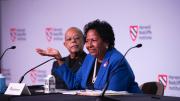The hard part has barely begun. That was the reality that kept surfacing last Friday during an all-day conference at the Radcliffe Institute exploring questions raised by the 130-page report Harvard released last week documenting the University’s historic ties to slavery. The most urgent of those questions relate to repair and atonement, and to what the University must do now, after the years-long effort to bring this fuller history to light. The answers were not easy, nor were they merely theoretical: included in the report were a series of broad recommendations for redress, to which the Harvard Corporation announced it would commit $100 million. One practical aim of the conference, which was anchored by keynote addresses from former Brown University president Ruth Simmons, Ph.D. ’73, and anti-racism activist and historian Ibram X. Kendi, was to begin digging into specific ideas for action.
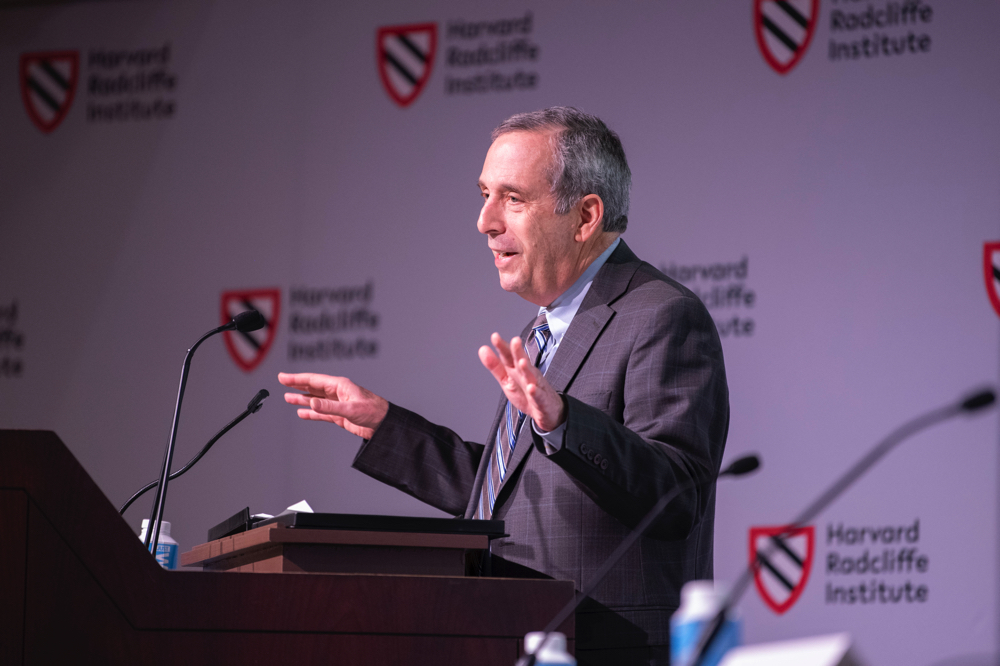
President Lawrence S. Bacow pledged Harvard resources to "try and help repair the damage caused by slavery and its legacy."
Photograph by Tony Rinaldo Photography; courtesy of Harvard Radcliffe Institute
“All of us at Harvard—all of us—are heirs to all that Harvard is,” President Lawrence S. Bacow said in remarks leading off the event, hosted both in person and online, “and we cannot claim to stand for truth if we limit our view of the past.” He reiterated the report’s major findings: that more than 70 people had been enslaved at Harvard, that faculty members had given scholarly legitimacy to ideas of racial superiority, and that the University continued racially discriminatory practices for many decades after slavery ended. “That this truth has been obscured for so long should prompt our indignation—and it does,” he said. “But more importantly, it must also prompt our action….You have my pledge that we will marshal this institution’s resources—our intellectual resources, our reputational resources, and, yes, our financial resources—to try and help repair the damage caused by slavery and its legacy.”
“We can’t dismantle what we do not understand,” said Radcliffe dean and Paul professor of constitutional law Tomiko Brown-Nagin in her own introductory remarks. “And we can’t understand contemporary injustice unless we reckon with our history. And we’re doing just that at Harvard.” Brown-Nagin led the Presidential Committee on Harvard and the Legacy of Slavery, which produced last week’s report.
Throughout the rest of the day, in speeches and panel discussions, more than two dozen experts—historians, legal scholars, poets, musicians, students, academics from abroad, administrators from other universities—weighed in on what form that repair might take.
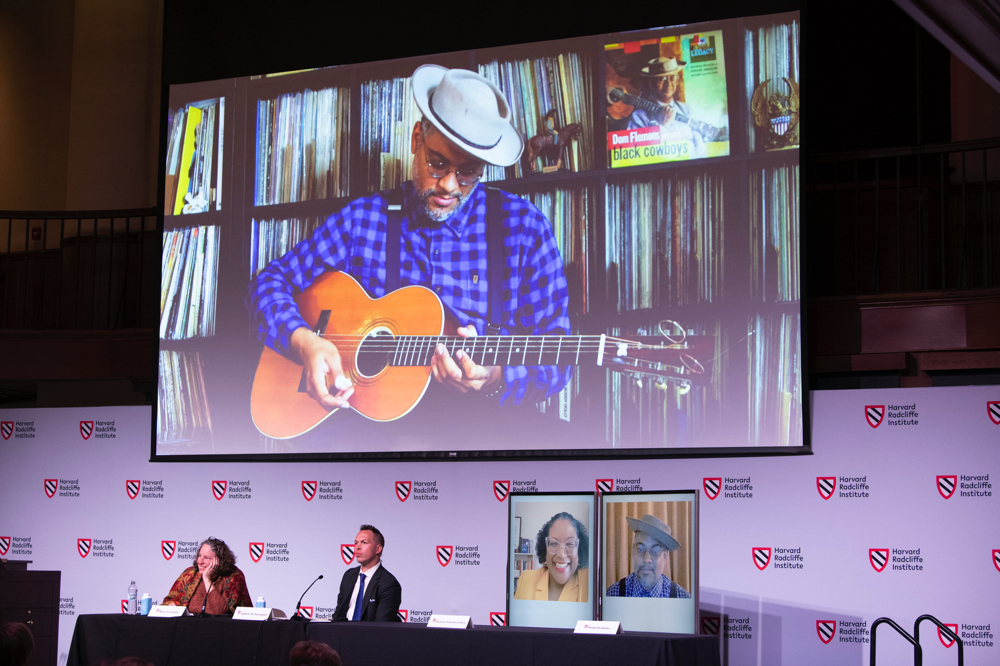
Musician Dom Flemons, co-founder of the Grammy-winning old-time stringband Carolina Chocolate Drops, performs during a panel on engaging the public in history. Other members of the panel included (seated, from left) moderator Meira Levinson, Thompson professor of education and society; Getting Word Oral History Project director Andrew M. Davenport; and poet and literary scholar Honorée Fannone Jeffers, who joined via video.
Photograph by Tony Rinaldo Photography; courtesy of Harvard Radcliffe Institute
Densil A. Williams, pro vice chancellor and campus principal at the University of the West Indies, suggested Harvard set up a long-term scholarship fund for black students from the African, Caribbean, and Pacific region—an area of the world where Harvard and its early donors held many close and lucrative connections to slavery. Scholarship recipients would study robotics, artificial intelligence, and big data, Williams said—“all those things that matter in the new economy”—and then return home with their new skill sets “to build their societies.”
Museum curators offered insights on how Harvard might memorialize enslaved people—as the report recommends—drawing on their own experiences structuring exhibits about slavery-related topics. Kyera Singleton, executive director of the Royall House and Slave Quarters spoke about the museum’s transition to foregrounding the lives and stories of enslaved people on a site where their existence had previously been erased. Julia Rose, historic house manager at Maryland’s Marietta House Museum, and Kevin Young ’92, director of the National Museum of African American History and Culture, spoke about helping visitors overcome the initial “resistance” they may have to difficult materials on display. Cycling through slides showing Harriet Tubman’s hymnal and handkerchief, a slave cabin from South Carolina, and an animated digital graphic showing the chilling histories of two slave ships, Young said, “It’s about witnessing,” which he defined as an act of seeing but also speaking. “That’s part of it, the curatorial aspect of witnessing, of being able to tell a story that people can relate to, because the facts sometimes can be overwhelming.”
Other speakers came with urgent admonitions. Pumla Gobodo-Madikizela, a professor of historical trauma at Stellenbosch University in South Africa who served on South Africa’s post-apartheid Truth and Reconciliation Commission, spoke of the importance of following through with the recommendations for repair outlined in the report. The Truth and Reconciliation Commission in South Africa “failed spectacularly” in some ways, she said, despite the hope, possibility, and genuine good work that ushered in new policies, laws, a new constitution. More than 20 years later, the country has seen a resurgence of racism and racial conflict. “There is something profoundly difficult about moving forward,” she said. “It seems to me that the focus on the spectacular aspects of this violence”—tortures and killings—“is what trips us up.” Instead, the more urgent need is to focus “on the everyday continuities of this violence….The continuities are not these spectacular, dramatic forms of violence; they are much more subtle. And it’s easy to deny the realities, easy to erase these kinds of continuities because they are not as visible.”
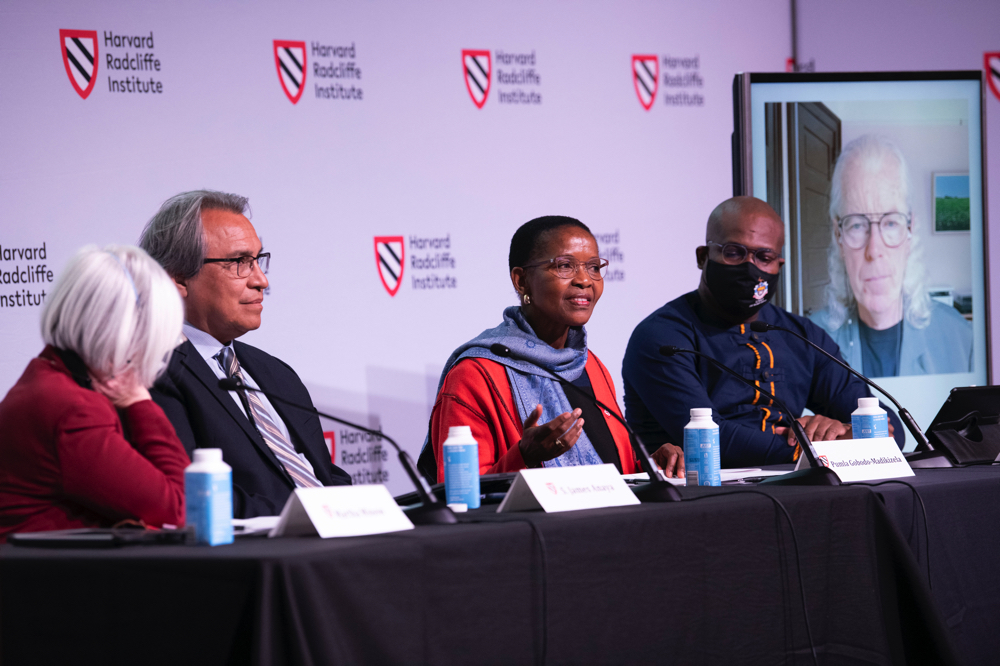
Martha Minow (left) with panelists S. James Anaya, J.D. '83, Pumla Gobodo-Madikizela, Densil A. Williams, and Simon P. Newman (who joined the discussion via video).
Photograph by Tony Rinaldo Photography; courtesy of Harvard Radcliffe Institute
Ana Lucia Araujo, a Brazilian-born historian who teaches at Howard University, pointed out that Harvard’s “cultural memory of the history of slavery” as embodied in its buildings, monuments, and museum collections, right now reflects “the cultural memory of those who benefited from slavery,” not those who were its victims. That’s an important fact to consider, she says, in thinking about the timing of Harvard’s self-investigation. “If Harvard and other universities are trying to tell the history about what happened in the past, it’s not because people do not know what happened in the past,” she said. “It’s not because the records haven’t been there; these records that we are talking about—and even the sites of memory—they have been there for decades. We should be asking ourselves, ‘Why now? Why only now are we doing that?’ There were no concrete obstacles that prevented this history from coming to light.”
Kemeyawi Q. Wahpepah, a Ph.D. student in the Harvard Graduate School of Education (HGSE) with Native American ancestry, also discussed how Harvard’s history weighs on its present, and how long-ago events shape the experiences of current students from black and indigenous backgrounds, many of whom she has interviewed for a forthcoming research project with sociologist and HGSE assistant professor Anthony Jack. “Students come to Harvard as whole human beings,” she said. “And with them, they bring the realities of the lived experiences of racism and economic inequality.” Partnerships with black and Native communities—another of the recommendations included in the report—“must better account for where students are coming from right now,” Wahpepah urged. Meanwhile, tracing the “propulsive” history of slavery and racism in higher education, journalist and author Adam Harris also spoke about the importance of time, emphasizing that “commitments to amends need to be sustained. The momentum that our inequitable system has built will not be blunted in a week, a year, a decade.”
That sentiment was echoed later in the day by Simon P. Newman, a historian at the University of Glasgow, who led that institution’s investigation into its own slavery connections, producing a report in 2018. “Reparative justice is a long-term project,” he said. “Atlantic World slavery existed for more than 20 generations, and meaningful reparative justice cannot be achieved overnight. It’s about much more than money. Long-term developmental programs, engaging with education, sustainable development, medicine, economic development, art, culture, and so much more are going to be required.” Later, elaborating on the “multi-generational reparative justice program” he envisioned, he said: “It’s going to require academics who haven’t even been hired by the University of Glasgow yet, and students who haven’t even been born, to be a part of this process going forward. All I can say is, it’s really hard work. It’s very easy to say, ‘We’re going to give money and do this.’ It’s much harder to actually work out how to do it.”
Jody Lynn Allen, a historian at The College of William & Mary, offered a glimpse of what that harder work looks like. The director of its slavery-reconciliation program, The Lemon Project (named after a man who was enslaved at the college), she talked about the process of gaining trust from a local African American community scarred by past interactions with the college. Launched in 2010, The Lemon Project’s programming has involved archival research, symposia, “listening sessions,” teaching programs, a genealogy initiative, and a public memorial to the enslaved, which was unveiled on William & Mary’s campus last weekend. “We recently had a meeting with the student assembly,” Allen said, “and the big question was, is The Lemon Project finished? And the answer is, of course not. We’re not even sure we’re in the middle of this yet.”
Similarly, Andrew M. Davenport, director of the Getting Word Oral History Project based at Thomas Jefferson’s Monticello estate, talked about the profound and ever-expanding work of finding, connecting with, and interviewing the descendants of people who were enslaved by the founder and former American president. (Among the Harvard report’s recommendations is that the University should “identify, engage, and support direct descendants” of those enslaved at Harvard and by its affiliates.) Toward the end of his talk, Davenport revealed that the Monticello descendants include his own family: his great-great-great grandfather, Edmund Robinson, was one of more than 200 people sold after Jefferson’s death to pay off debts. Finding out that history—in part through the work of Getting Word’s founders—“immeasurably enriched” his life, Davenport said. “Institutions can and should do this kind of work. They should reconnect families, if possible. They should try.”
Ruth Simmons offered a slightly longer view of the same kind of work. As president of Brown University in the early 2000s, she began an investigation—the first university to do so—into Brown’s historic connections to slavery. The research produced a landmark report in 2006, and in the years since, dozens of other universities have taken up the same task. (In his opening remarks, Bacow, addressing Simmons, said, “Ruth had the courage to act before any of the rest of us did….I’m sorry that it took some of us as long as it has to follow the path that you identified for all of us”). Now president of Prairie View A&M University, a historically black university in Texas, Simmons recalled the events of that groundbreaking examination at Brown. “Some argue even today that the history of slavery should be buried and forgotten,” she said. “I hear this all the time.” But “the legacy of false or incomplete histories has left us with an acute sense of betrayal” and minimized the injuries of crimes against humanity. “There’s a moral obligation we have as human beings to address the legacy of such deeds. I always think about it this way: the longer you wait to address that, not only are you complicit in that evil, but you have a new evil that you’ve created….When I think about my grandchild and the future she will have, I think how different it could have been if only people had seized the opportunity to deal with these issues.”
In conversation with Fletcher University Professor Henry Louis Gates, Jr., Simmons recalled that there came a moment when she was forced to ponder her own personal reaction, as a black woman whose ancestors were enslaved, to the fact that, for instance, the desk in her office once belonged to James Manning, the university’s slave-owning first president, whose portrait also hung on the wall in front of her. “That caused some necessity for me to think,” she said. “And I’m glad I had the opportunity to do that. In the end, I thought: how satisfying it is.” After the audience’s laughter subsided, she turned to Gates: “This is the magic and the magnitude of what you’re doing,” she said. “You’re involved in a process that creates exactly those kinds of dynamics.”
The effort that Harvard is undertaking may be even harder than it was 20 years ago at Brown, she said. “I thought the climate at that time was somewhat inhospitable for tackling such fraught questions,” but today the work is perhaps even more challenging, she noted, “given the organized efforts to oppose truths about slavery that are now sweeping the country.” Moderating a panel discussion later in the day, 300th Anniversary University Professor Martha Minow—who chairs the committee charged with carrying out the recommendations in last week’s report on Harvard’s ties to slavery—echoed Simmons’s concern. “Part of our work now requires vigilant attention to the reactionary responses to what we are doing here today,” she said. “I cannot help but recall the judicial reactions to the post-Civil War Reconstruction amendments in this country, undoing their meaning, undoing their intention. And we are living through, I fear, another reaction of that nature, the response to resurfacing ideologies that some may use to justify subordination, exclusion, dehumanization. That backlash has to be part of what we understand as the legacy of slavery. And the backlash to hard-won struggles has to be what we anticipate as we do the hard work right now.”
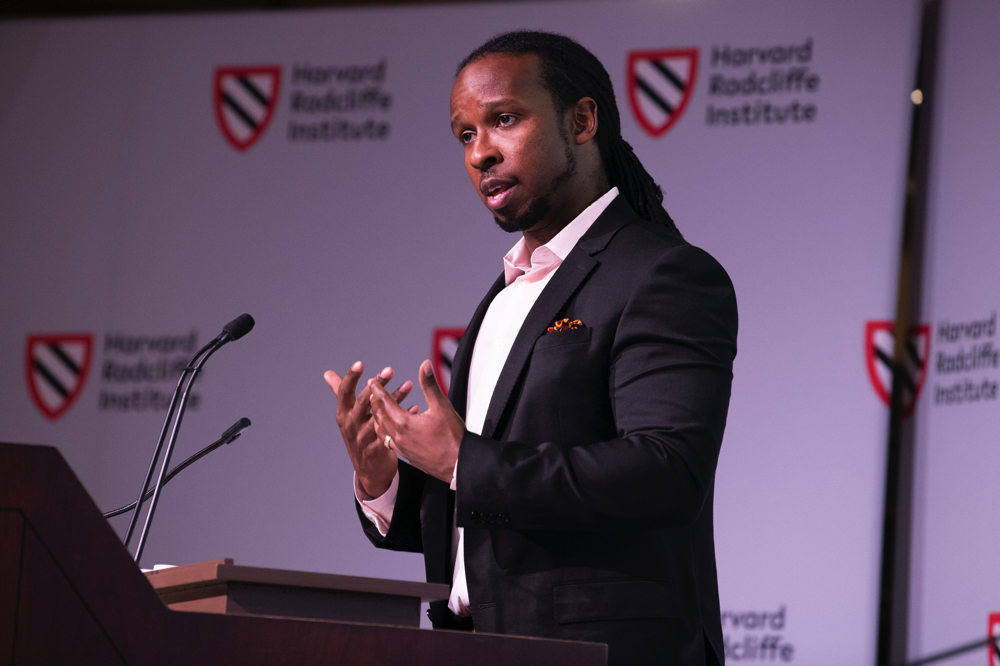
Anti-racism activist and historian Ibram X. Kendi
Photograph by Tony Rinaldo Photography; courtesy of Harvard Radcliffe Institute
Ibram X. Kendi’s keynote, too, carried a similar warning. He wound his remarks around the story of a Harvard-trained physician, Edward Jarvis, 1826, M.D. ’30, who spent his last years trying unsuccessfully to retract a scholarly paper he’d published, which had concluded that freedom was more damaging to African Americans’ mental health than slavery. The paper was based on what he later discovered to be inaccurate data in the 1840 census, but his retractions of the original, discredited thesis never seemed to stick. “A Georgia congressman reportedly told Jarvis it was too good of a lie,” Kendi said. “It was so good that this legacy of slavery still lives with us to this day.” Going further, he added later, “Right now, the defenders of the creed of slavery and inequality are attacking the truth, not only by spreading lies about bad being good, but by attacking the credibility of the searchers and deliverers—in our case, universities and scholars and scientists—by reducing our research findings to beliefs, to politics, by framing us all as activists or grifters or operatives.”
Amid all of this, one crystallizing moment came in the middle of the day, when the conference broke for lunch and 40 or so participants headed out to the sunken garden in Radcliffe Yard for what the event program had described as a “silent moment of grounding, reflection, and remembrance” honoring the enslaved. Melissa Wood Bartholomew, Harvard Divinity School’s associate dean of diversity, inclusion, and belonging, and Erica Williams, a graduate student in divinity, led the group in a libation ceremony—a ritual practiced by cultures and religions around the world. “We are rooted,” Bartholomew said, introducing the ceremony, “in the African worldview that reminds us, and in the indigenous worldview that reminds us, that there is no separation between those who come before us, those who are here right now, and those who have yet to come.” Then, as audience members read aloud the names of people enslaved at Harvard from cards that Bartholomew had handed out a few moments earlier, Williams poured water into the ground from a large glass pitcher. An initial air of fluttery awkwardness fell away, as name after name after name was spoken and the silence around each deepened: “the Moor,” Titus, Venus, Juba, Bilhah, Dinah, Cesar. Some were not even names, just descriptions—“a little boy,” the wife of Pequot sachem Mononotto, Bilhah’s newborn son—and many were not even that. “Name unknown,” recited one person after another, reading from the cards. “Name unknown, name unknown.” After each pause, as Williams poured water from the pitcher, the group intoned the African word “ashay,” whose meaning is akin to “amen.” Then Bartholomew invited everyone to call out the names of other formerly enslaved people whom they wanted to honor, and a few did. “Ashay,” everyone said, “ashay, ashay.” Finally, the pitcher was empty and the garden was quiet.
“Go in peace,” Bartholomew said.
“Thank you for sharing this time with us and for honoring our ancestors,” Williams said, as the group slowly turned to walk back toward the conference.
